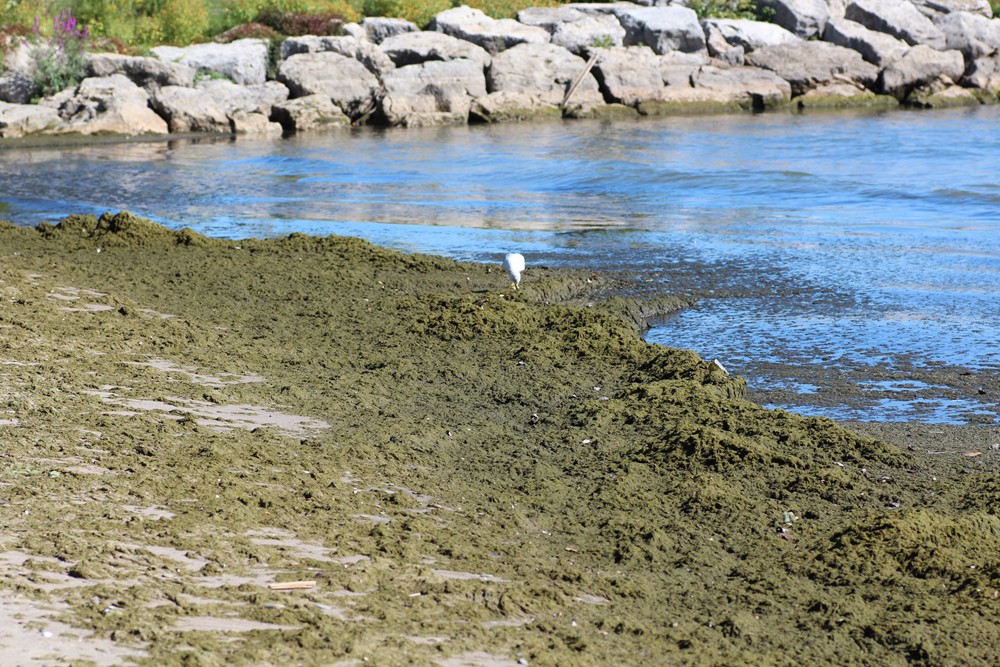by W.D. McIlveen
On February 27, 2014, the International Joint Commission [I.J.C., 2014] released a report on the most recent algae bloom problem in Lake Erie. That report had much in common with a similar problem that existed in the Great Lakes about 50 years before. That problem was the association between phosphorus loading in the water column and the subsequent growth of algae, most conspicuously Cladophora glomerata, though blue green bacteria and other species constitute additional problems.

Algae, like all aquatic organisms, are dependent upon the chemical constituent chemicals in the surrounding water. Generally, chemical concentrations in the water are quite dilute. As it turns out, the essential chemical that is most limiting for algal growth is phosphorus. As a result, small increments in the level of soluble phosphorus cause large responses in growth of the algae. When phosphorus levels in lake water increased up into the 1960s, excessive growth of algae occurred in the Great Lakes. The algae washed up on the shores of the lake (Figs. 1 and 2) where it began to decay and caused very unpleasant odors. Decaying algae consumes oxygen and when this happens in the aquatic environment, the eutrophic conditions with insufficient oxygen become limiting to many organisms including fish.

There were many sources of the phosphorus, however, the prime source was attributed to detergents used by human residents around the lakes [Schindler, 2008]. Despite fierce resistance from the soap and detergent industry, they were forced to remove the phosphate-based chemicals from their product by 1972. Following this, phosphorus levels in the water gradually declined and the algae problem generally improved. The removal of phosphorus from detergents did not permanently solve the problem. There was year to year variation in algae growth and the problem appeared in years of heavy growth (Fig. 3).

Over time, the human population around the lakes increased further. Other sources of phosphorus grew including releases from sewage treatment plants. As well, new complicating factors appeared. Global warming caused earlier warming of the near-shore waters with the result that alga populations could become established earlier in the Spring. The appearance of the Zebra (Dreissena polymorpha) and then Quagga (Dreissena bugensis) Mussels made major changes in water quality. These species filter huge quantities of water with the result that water is made clear. With clearer water, light could penetrate to greater depths and this effectively extended the area over which the algae could attach and grow. More growth means more problems. Other introduced species such as the Round Goby (Neogobius melanostomus) and large populations of waterfowl that now feed on the mussels further complicate the picture.
In Lake Ontario, the water current in the western portion of the lake is generally counter clockwise when seen from above. This means that the currents along the shoreline off Peel and Halton are from east to west. The Halton shoreline is therefore downstream from any sources of phosphorus in Peel and the City of Toronto. In addition, the nature of the shoreline with piers and other structures influence the movement of the water and can cause floating algae to become trapped. Winds and storms can deposit, and remove, algae on the shore where it is an unwelcome caller in the minds of local residents.
The recent report by the IJC [IJC, 2014] has concluded that the most recent problem of algae in Lake Erie was mainly due to agriculture. This includes large animal production facilities and heavy use of fertilizers for crop production around the Lake. As well, residential use of fertilizers for lawns and gardens contribute a significant amount of phosphorus. The latter source was also confirmed in studies completed in Halton [Aquafor Beech, 2006]. These sources need to be addressed or the eutrophication problem will persist and grow. It is still too early to know what measures will be undertaken in coming years. Phosphate-free lawn fertilizer may be mandated for home-use for example. Conditions around Lake Erie must be altered or the algae issue will continue and grow. The so-called ‘dead lake’ state could return even though eutrophication actually represents a hyper-lively water body.
References Cited:
Aquafor Beech Limited. 2005. Final report prepared for Conservation Halton LOSAAC Water Quality Study. 127 pp.
International Joint Commission. 2014. A Balanced Diet for Lake Erie: Reducing Phosphorus Loadings and Harmful Algal Blooms. Report of the Lake Erie Ecosystem Priority. 100 pp.
Schindler, D.W. and J.J. Vallentyne. 2008. The Algal Bowl – Overfertilization of the World’s Freshwaters and Estuaries. University of Alberta Press, Edmonton. 323 pp.
